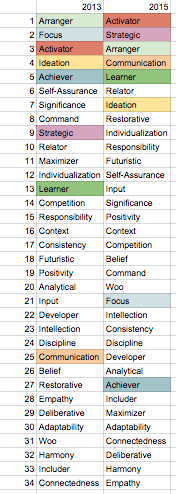Back in June 2013, I took the Clifton StrengthsFinder test. The test is 177 questions with a 20-second timer for each question. Based on your results, the 34 strengths in the StrengthsFinder system is ranked for you. By paying $9.95, I was able to get my Top 5 Strengths along with detailed descriptions of each.
In 2013, these were my top five (with my paraphrased description of each):
- Arranger: bring people, tools, and other resources together to get things done
- Focus: prioritize and take action, staying on track
- Activator: take ideas and turn them into action
- Ideation: make unlikely connections and come up with new and innovative ideas
- Achiever: take pride and get satisfaction from hard work and productivity
In the past 18 months, I feel like I’ve changed in many ways. I tried to re-take the test with my existing account, but when the web app told me that I couldn’t, I checked the FAQ to find this:
Your first completion of the Clifton StrengthsFinder assessment will yield the purest and most revealing results. For this reason, each Clifton StrengthsFinder access code is valid for only one time through the assessment. Taking the Clifton StrengthsFinder more than once may actually skew the validity of the results.
I figured that since it had been a long time, I would be approaching the questions with a fairly “pure” mind. I bought an access code under a different account and took the test. Here are my 2015 results:
- Activator: take ideas and turn them into action
- Strategic: spot patterns and challenges and map ways to move forward
- Arranger: bring people, tools, and other resources together to get things done
- Communication: easily put thoughts into words and also like to converse and present
- Learner: interested in continuously improving and excited about acquiring knowledge and skills
Activator and Arrange are still in my top five, but I’ve replaced three of the strengths. I was curious about where my former top five strengths went and equally curious about where the new strengths came from. I opted for access codes (an extra $79 each for 2013 and 2015) to show me the full ranking of the 34 strengths.  A few things I noticed:
A few things I noticed:
- Communication took a big leap from #25 to #4. This may have a lot to do with my efforts to write every single day. I’ve also been proactively seeking out opportunities to give talks and participate in panels. I used to shy away from such things, but nowadays, I find them to be valuable exercises for organizing my thinking and honing my skills as a communicator.
- Achiever dropped from #5 to #27. Part of this has been a result of developing better time management skills on my part. I feel like I do a lot more in less time these days. I also don’t equate “keeping busy” with “being effective” as much as I used to, so I think such line of thinking was reflected in my answers.
- Focus dropped from #2 to #21. I’ve been trying to shift the nature of my work to the “important, not urgent” quadrant, which I find is less about measurable progress on a daily basis and more about spending time thinking about challenging questions. In 2013, I was spending a great deal of time executing on various marketing and business development activities which involved strict to do lists. These days, some of my activities are open-ended and take several days or weeks to see movement. For example, thinking about our team’s vision-based framework or overhauling our performance review system are complex initiatives that benefit more from strategic thinking than methodical focus.
- Ideation had a slight drop from #4 to #7, but I like to pair this with the jump of Strategic from #9 to #2 (and also the jump of Activator from #3 to #1). I used to love coming up with new ideas all the time and getting really excited about them. One thing that’s bothered me in the past couple of years is the lack of followthrough on a lot of my ideas. I’ve been spending more time creating frameworks and writing detailed plans for new initiatives so that there is greater clarity around how new ideas will come to life and what impact they’ll have.
It’s easy to read into tests and find yourself trying to create coherent narratives for the results. Ultimately, I don’t think it’s the most productive use of time to get too obsessed with StrengthsFinder results. For me, I enjoyed retaking the test and refreshing my memory on the 34 strengths. It’s a great way to help me articulate and describe strengths I might observe and discuss with my team members. I also enjoyed seeing the change in my results. While old habits are often hard to let go, I’ve worked hard to evolve and adopt new habits. While I won’t read too much into this test, the signs are at least encouraging.